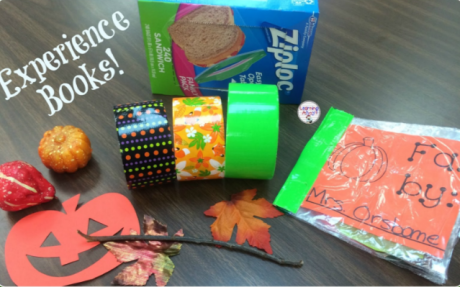(Note: If you’re already sold on Experience Stories, watch for suggestions for using them to practice language, vocabulary, auditory skills, reading and more. Coming Soon!)

Experience stories are a fun and easy way to practice language. They can be created and enjoyed both at home and school and are helpful for any child with language goals.
WHAT IS AN EXPERIENCE STORY? An experience story begins as an activity that an adult shares with a child. After the activity, a story is created, targeting language that the child needs to practice. The story includes photos taken during the activity and the child is the main character. It is read together often, providing repeated practice with the target language.
The benefits of these personalized books are many.
-
The adult can control the language and vocabulary that is used, or wait and see what the child attempts to say during the activity.
If the child needs repetitive, structured practice with language, experience stories can be a fun and motivating way to accomplish that. The parent, teacher or therapist can also use experience stories to expand the child’s language if the child has complex language or learns language more naturally .
-
A single language target can be practiced many times.
Here are some examples for a Banana Split Experience Story targeting noun-preposition-noun. New vocabulary is in italics.
The bananas were in the pantry. Anna put the bananas on the counter. The ice cream was in the freezer. Mom put the ice cream on the counter too. Anna put the banana in the bowl. Then mom put three scoops in the bowl. Anna squeezed chocolate on one scoop.Then Anna poured strawberry on a scoop. Anna poured pineapple on the last scoop. Mom sprayed whipped cream in Anna’s mouth! Yum! Mom put whipped cream on three scoops. Anna put cherries on three scoops. Anna and mom made a banana split in the kitchen!

-
All verb tenses can be practiced around a single activity.
Involving the child in planning the activity (making a shopping list, etc.) allows you to use future tense to talk about the activity. Present tense is used during the activity. Past tense is used in the book.
-
The child can practice the same lesson over and over without losing interest.
-
The book created after the experience can be enjoyed for months, and becomes a keepsake documenting the child’s language growth.
-
By sharing the book with extended family, babysitters and others, caregivers can carry the learning over into their time with the child.
-
The text in the book promotes literacy. The child is reading about an activity she participated in, so she is likely to have a better comprehension of what she reads than if it were a commercial book.
-
The book can be used to practice listening and auditory comprehension. The adult says a sentence from the book and the child finds the picture.
-
The book can be used to practice pronoun use. When reading, the reader replaces her own name with ‘I’. If reading with the activity partner, she replaces the partner’s name with ‘you’ etc.
A Thought about Language During the Experience
It’s important that the Experience itself is fun, motivating and natural as possible.
It is not at all natural, while pouring pineapple, to say, “I am pouring pineapple on the last scoop.” But what if Grandma is on speaker phone, participating in the activity from afar? The child can give a play by play . Or the activity can become a cooking show. Mom is the host and asks, “So, Miss Anna Banana, please tell us what you are doing with the pineapple.” Dad could be in the living room and, on cue ask, “Anna, what’s happening now?” Be creative. Mix it up. Above all, keep it fun.
Those are great ideas!
Love THEM!
THANX!
LikeLike